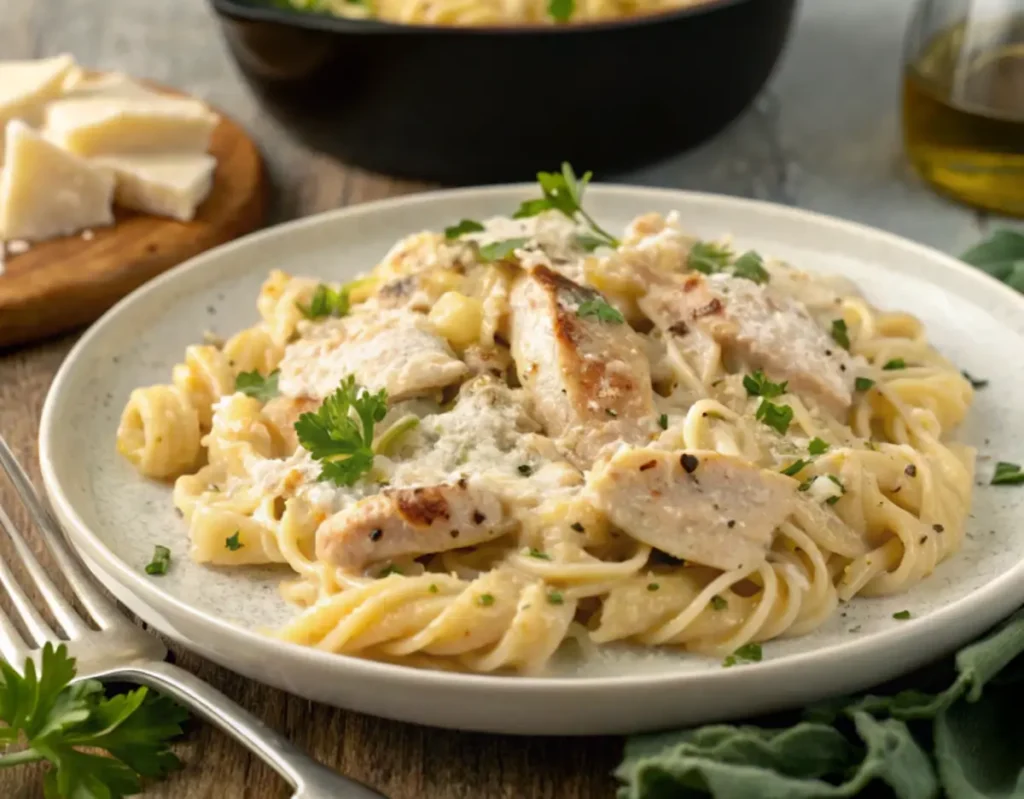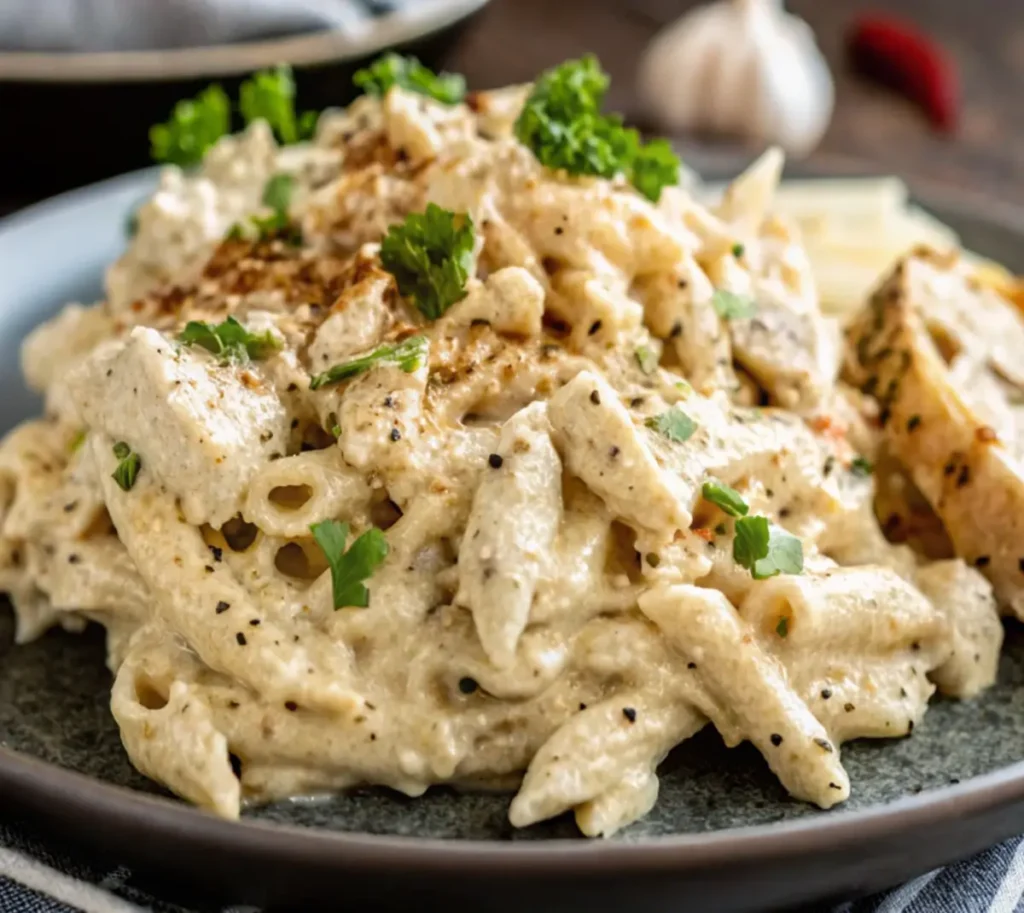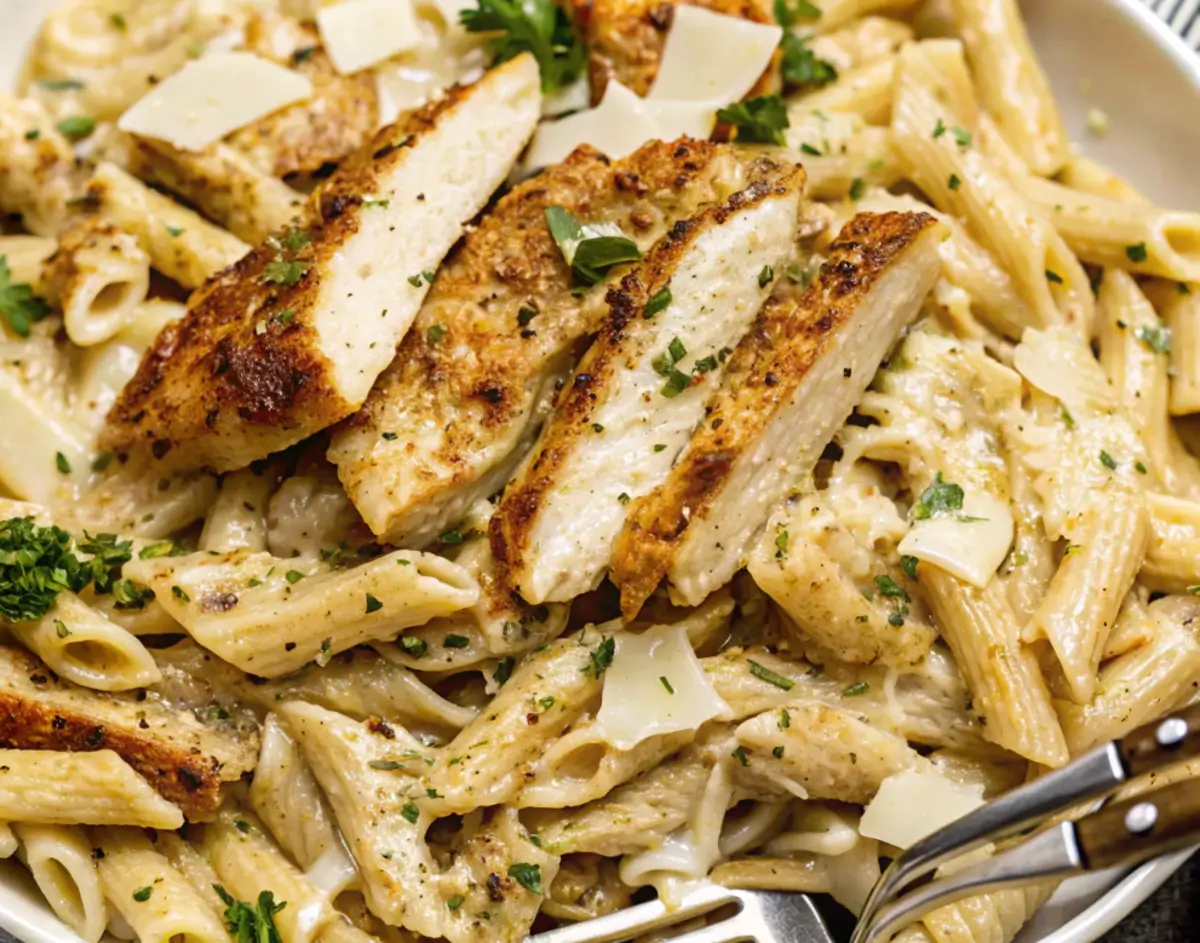Garlic Parmesan Chicken Pasta is more than just a meal; it’s a comforting embrace of Italian-inspired flavors, creamy textures, and aromatic herbs that bring people together. Whether it’s for a cozy family dinner or an indulgent treat after a long day, this dish captures the hearts—and taste buds—of everyone at the table.
What Makes This Dish a Family Favorite?
Garlic Parmesan Chicken Pasta has all the makings of a perfect family meal. Here’s why it’s a frequent flyer on dinner tables:
- Versatility: The recipe can easily adapt to picky eaters or adventurous palates with add-ins like vegetables, spices, or different proteins.
- Comfort Food Status: Creamy pasta combined with garlic and parmesan creates a rich and satisfying experience.
- One-Pan Wonder: It’s an ideal choice for busy families looking to minimize cleanup while maximizing flavor.
- Crowd Pleaser: The combination of chicken, pasta, and creamy sauce ensures that there’s something for everyone.
The Role of Garlic and Parmesan in Italian-Inspired Cuisine
Garlic and Parmesan cheese are the backbone of many Italian dishes, giving this pasta its signature taste:
- Garlic: A key ingredient that brings a warm, slightly sweet, and deeply aromatic base to the dish. Fresh garlic cloves add complexity, while roasted garlic offers a mellow flavor.
- Parmesan Cheese: Known as the “king of cheeses,” Parmesan is nutty, tangy, and full-bodied. Its aged texture melts beautifully into the sauce, enhancing its creaminess.
Together, these ingredients create the robust flavor profile that Italian cuisine is renowned for.
How Chicken Elevates the Dish’s Flavor Profile
The addition of juicy chicken takes this pasta dish from good to unforgettable:
- Umami Boost: Chicken introduces a savory richness that complements the garlic and parmesan.
- Texture Variety: Crisp, golden-brown chicken contrasts beautifully with the silky pasta and sauce.
- Protein Power: It makes the dish more filling and balanced, perfect for a complete meal.
The preparation method matters; whether pan-seared, grilled, or baked, the cooking technique directly impacts the final flavor.
The Importance of Pasta Texture in This Recipe
The texture of the pasta plays a crucial role in how well the sauce clings to each bite:
- Al Dente Perfection: Slightly firm pasta prevents the dish from becoming mushy and holds up well to the creamy sauce.
- Pasta Shapes: Fettuccine, penne, or linguine are ideal options, each offering a unique mouthfeel and sauce coverage.
Mastering pasta texture ensures that every bite is a harmonious blend of flavors and textures.
Ingredient Overview
Before diving into the recipe, knowing your ingredients inside out ensures the dish shines in every way.
Fresh Ingredients vs. Packaged Options
Using fresh ingredients elevates the flavor:
- Fresh Garlic: Its natural oils create a more pronounced and aromatic flavor compared to garlic powder.
- Homemade Pasta: While packaged pasta is convenient, fresh pasta adds a tender, melt-in-your-mouth texture.
- Organic Chicken: Opt for organic or free-range chicken for the best taste and nutritional benefits.
However, for convenience, high-quality packaged options can still yield excellent results when chosen wisely.
Selecting the Right Type of Parmesan Cheese
Not all Parmesan cheeses are created equal:
- Authentic Parmigiano-Reggiano: Aged for at least 12 months, it delivers a depth of flavor unmatched by pre-grated varieties.
- Pre-Grated Cheese: While convenient, it often contains additives that can affect the texture and taste of your sauce.
Grating fresh Parmesan ensures that you get the purest, richest flavor in every bite.
The Debate Over Fresh Garlic vs. Garlic Powder
Both forms of garlic have their merits:
- Fresh Garlic: Provides bold, natural flavor and is ideal for sautéing to release its aromatic oils.
- Garlic Powder: Adds convenience and a milder flavor, perfect for seasoning the chicken or sauce in a pinch.
While fresh garlic is typically preferred for this recipe, garlic powder can serve as a quick alternative without sacrificing too much flavor.

Prepping for Success: Kitchen Essentials
Preparation is the key to a smooth and enjoyable cooking experience.
Essential Cookware and Tools
To make Garlic Parmesan Chicken Pasta, you’ll need the following:
- Large Non-Stick Pan: For cooking the chicken and sauce seamlessly.
- Pasta Pot with Strainer: Ensures easy draining without breaking the pasta.
- Microplane Grater: Perfect for achieving finely grated Parmesan cheese.
- Sharp Chef’s Knife: For precise slicing of garlic and chicken.
- Whisk: To create a smooth and creamy sauce without lumps.
Investing in quality cookware makes the process smoother and the results more professional.
Time-Saving Tips for Busy Home Cooks
Short on time? Here are ways to streamline the process:
- Pre-Cut Ingredients: Use pre-minced garlic and pre-sliced chicken to shave off prep time.
- One-Pot Method: Combine steps to cook pasta, chicken, and sauce in the same pan for less cleanup.
- Meal Prep: Cook the chicken and chop the garlic in advance to save time on busy weeknights.
With these tips, Garlic Parmesan Chicken Pasta can be prepared efficiently without compromising on flavor.
Cooking Garlic Parmesan Chicken Pasta: A Step-by-Step Guide
Making Garlic Parmesan Chicken Pasta is a rewarding experience, especially when you follow each step carefully. To create the perfect dish, we’ll break it down into manageable stages, ensuring that each component shines on its own. From preparing the chicken to assembling the final dish, this guide will walk you through every step with simple instructions.
Preparing the Chicken: Marinade and Cooking Techniques
First and foremost, perfectly cooked chicken is key to this dish’s flavor and texture. Taking time to properly prepare the chicken ensures it becomes the star of the meal.
How to Get a Golden, Crispy Exterior on Chicken
To achieve that irresistible golden-brown crust, follow these easy steps:
- Pat the Chicken Dry: Before seasoning, use a paper towel to remove excess moisture. This helps the surface crisp up during cooking.
- Season Generously: Use a combination of salt, pepper, garlic powder, and paprika for a well-rounded flavor.
- Use the Right Pan: A heavy-bottomed skillet or cast-iron pan works best for achieving even browning.
- Cook Over Medium-High Heat: Heat your oil (olive or vegetable oil) until shimmering, then sear the chicken undisturbed for 4–5 minutes on each side.
By following these steps, the chicken develops a crisp exterior while remaining tender and moist inside.
Ensuring Tender and Moist Chicken Every Time
To keep the chicken juicy, consider these tips:
- Butterfly Thick Breasts: If your chicken breasts are too thick, slice them horizontally for even cooking.
- Marinate for Flavor: A quick marinade of olive oil, lemon juice, garlic, and Italian seasoning infuses flavor while tenderizing the meat.
- Don’t Overcook: Use a meat thermometer to check the internal temperature, aiming for 165°F (74°C).
These small adjustments make all the difference in creating perfectly cooked chicken every time.
Making the Garlic Parmesan Sauce
Now that the chicken is ready, it’s time to move on to the heart of the dish: the creamy, garlicky parmesan sauce. This sauce ties everything together with its rich flavor and velvety texture.
Achieving the Perfect Sauce Consistency
Consistency is everything when it comes to this sauce. Here’s how to get it just right:
- Start with a Roux: Melt butter in a pan, then whisk in an equal amount of flour. Cook for 1–2 minutes to eliminate any raw flour taste.
- Add Liquids Gradually: Slowly pour in chicken broth and heavy cream, whisking constantly to prevent lumps.
- Simmer for Thickness: Let the sauce cook over low heat until it reaches your desired consistency. This should take about 5–7 minutes.
Remember to keep whisking as the sauce simmers to achieve a smooth, creamy result.
Infusing the Right Amount of Garlic Flavor
Garlic is a defining feature of this dish, so here’s how to make it stand out without overpowering the sauce:
- Sauté Fresh Garlic: Begin by lightly sautéing minced garlic in butter to release its aroma. Be careful not to burn it, as this can result in a bitter flavor.
- Adjust to Taste: If you prefer a stronger garlic flavor, add roasted garlic for a sweeter, milder depth.
By balancing fresh and cooked garlic, you’ll achieve a sauce that’s flavorful yet harmonious.
Pasta Perfection
The next step is preparing the pasta, which serves as the canvas for your garlic parmesan creation. Cooking it properly ensures the dish feels cohesive and indulgent.
Cooking Pasta Al Dente: Timing Is Everything
Getting the pasta just right is crucial. Here’s a foolproof guide:
- Boil with Salted Water: Use plenty of water with a generous amount of salt to flavor the pasta as it cooks.
- Check the Timing: Follow the package instructions but check for doneness 1–2 minutes early. Al dente pasta should have a slight bite to it.
- Save Pasta Water: Reserve a cup of starchy pasta water before draining. This can be used to loosen the sauce and help it cling to the pasta.
Al dente pasta ensures that the dish doesn’t feel overly soft or heavy.
Best Practices for Mixing Pasta with Sauce
Once the pasta is cooked, it’s time to bring everything together:
- Combine in the Sauce Pan: Add the drained pasta directly to the pan with the garlic parmesan sauce. This allows the pasta to absorb the flavors.
- Use Pasta Water: Add small amounts of reserved pasta water to thin the sauce as needed, ensuring it coats every strand or piece evenly.
- Toss Thoroughly: Use tongs or a wooden spoon to mix the pasta and sauce until fully combined.
This method creates a perfectly cohesive dish with the ideal balance of pasta and sauce.
Assembly and Final Touches
Finally, it’s time to combine all the elements for a truly show-stopping meal.
Combining All Elements for Maximum Flavor
Here’s how to assemble the dish like a pro:
- Layer the Pasta: Start with a bed of creamy pasta on each plate.
- Add the Chicken: Slice the cooked chicken into strips and arrange them neatly on top of the pasta.
- Drizzle Extra Sauce: Spoon any leftover garlic parmesan sauce over the chicken for an extra burst of flavor.
By layering the components thoughtfully, each bite delivers a harmonious blend of textures and tastes.
Toppings and Garnishes to Enhance Presentation
To finish, elevate your dish with simple yet stunning garnishes:
- Fresh Herbs: Sprinkle chopped parsley or basil for a pop of color and freshness.
- Extra Parmesan: Grate a generous amount of Parmesan cheese over the top for added richness.
- Cracked Black Pepper: A pinch of freshly ground black pepper adds a hint of spice and visual contrast.
These small touches not only enhance the flavor but also make the dish visually appealing, perfect for impressing your family or guests.

Creative Additions to Garlic Parmesan Chicken Pasta
Garlic Parmesan Chicken Pasta is a dish that’s already delicious on its own. However, with a little creativity, you can transform it into something truly extraordinary. Whether you want to make it healthier, add bold flavors, or tailor it to dietary preferences, the possibilities are endless. Let’s explore how you can take this classic recipe to the next level.
Flavorful Add-Ins: Vegetables and Herbs
Adding vegetables and herbs is one of the easiest ways to enhance the flavor and texture of your pasta. Not only do these additions make the dish more colorful, but they also add a fresh, vibrant twist.
How to Incorporate Spinach, Cherry Tomatoes, or Asparagus
Including vegetables in your Garlic Parmesan Chicken Pasta is simple and rewarding. Here’s how to use some popular choices:
- Spinach:
- Toss fresh spinach leaves into the hot pasta right before serving.
- The heat will wilt the spinach, adding a subtle earthiness that pairs beautifully with the creamy sauce.
- Cherry Tomatoes:
- Sauté halved cherry tomatoes in olive oil until they soften and release their juices.
- This adds a burst of sweetness and acidity that balances the richness of the sauce.
- Asparagus:
- Blanch asparagus tips in boiling water for 2–3 minutes, then toss them into the pasta.
- Their slightly crisp texture and mild flavor provide a delightful contrast.
These vegetables not only elevate the dish but also make it a bit healthier without compromising on flavor.
Fresh Herbs That Pair Well: Basil, Parsley, and Thyme
Herbs are an excellent way to add depth and aroma to your dish. Here’s how to use them effectively:
- Basil: Tear fresh basil leaves and scatter them over the pasta just before serving for a fragrant and slightly sweet finish.
- Parsley: Finely chop parsley and sprinkle it over the dish for a clean, fresh taste that balances the creamy sauce.
- Thyme: Use fresh thyme leaves during the cooking process to infuse the sauce with a subtle, woody flavor.
These herbs not only enhance the dish’s flavor but also make it look more vibrant and appetizing.
Protein Alternatives and Dietary Adjustments
If you’re looking to switch things up or accommodate dietary restrictions, there are plenty of ways to customize this recipe without losing its appeal.
Substituting Chicken with Shrimp, Salmon, or Tofu
Changing the protein in this dish can create an entirely new flavor profile. Here are some great alternatives:
- Shrimp:
- Sear shrimp in garlic butter for 2–3 minutes on each side until they turn pink.
- The natural sweetness of shrimp pairs wonderfully with the garlic parmesan sauce.
- Salmon:
- Grill or pan-sear salmon fillets and flake them over the pasta.
- The richness of salmon complements the creamy sauce beautifully.
- Tofu:
- Use firm tofu, press out excess moisture, and pan-fry it until crispy.
- This is a great option for vegetarians while still offering a satisfying protein.
By experimenting with these options, you can tailor the dish to suit your taste or dietary needs.
Making It Gluten-Free or Dairy-Free
Adapting Garlic Parmesan Chicken Pasta for specific dietary restrictions is easier than you might think:
- Gluten-Free:
- Use gluten-free pasta, such as those made from rice, quinoa, or chickpeas.
- Ensure any flour used for the sauce is gluten-free, like cornstarch or almond flour.
- Dairy-Free:
- Replace heavy cream with coconut milk or cashew cream for a creamy texture.
- Use nutritional yeast or vegan parmesan substitutes to mimic the cheese flavor.
These small adjustments allow everyone to enjoy this comforting dish, regardless of dietary restrictions.
Pairing Ideas for a Complete Meal
Garlic Parmesan Chicken Pasta is delightful on its own, but pairing it with complementary sides and beverages can make your meal feel more cohesive and satisfying.
Complementary Side Dishes: Salads, Garlic Bread, and More
Side dishes provide balance and variety to your meal. Here are a few options:
- Salads:
- A crisp Caesar salad with romaine lettuce, croutons, and a tangy dressing pairs perfectly with the creamy pasta.
- Alternatively, a light mixed greens salad with a lemon vinaigrette adds brightness to the meal.
- Garlic Bread:
- Toasted garlic bread or breadsticks are classic accompaniments, perfect for soaking up the creamy sauce.
- Roasted Vegetables:
- Roasted zucchini, bell peppers, or Brussels sprouts make a great side dish, adding depth and warmth to the meal.
These pairings enhance the overall dining experience by providing additional textures and flavors.
Storage and Meal Prep Tips
If you have leftovers or want to prepare in advance, there are a few things to keep in mind to preserve the dish’s flavor and texture.
How to Store Leftovers Without Compromising Flavor
Proper storage ensures your pasta tastes just as good the next day:
- Use Airtight Containers: Store the pasta and sauce together in a sealed container to prevent drying out.
- Refrigerate Promptly: Place leftovers in the fridge within two hours of cooking to maintain freshness.
Stored correctly, your Garlic Parmesan Chicken Pasta will stay delicious for up to 3–4 days.
Reheating Techniques for Best Results
Reheating pasta without losing its creamy texture can be tricky, but here’s how to do it:
- Stovetop Method: Add a splash of milk or broth to the pasta and warm it over low heat, stirring frequently.
- Microwave Method: Cover the dish with a damp paper towel and heat in short intervals, stirring between each one.
- Oven Method: For larger portions, place the pasta in an oven-safe dish, cover with foil, and bake at 350°F (175°C) for 15–20 minutes.
These methods ensure that the pasta remains creamy and flavorful, even after reheating.
Wrapping Up
Garlic Parmesan Chicken Pasta is not just a recipe; it’s a canvas for your culinary creativity. With endless possibilities for add-ins, substitutions, and pairings, this dish can be tailored to fit any occasion, dietary preference, or personal taste.
Whether you keep it simple or dress it up with vegetables, proteins, or sides, this pasta is always a satisfying and crowd-pleasing choice. Its versatility and rich, comforting flavors make it a dish worth mastering in your kitchen.
FAQs
- Can I use pre-grated Parmesan cheese?
Yes, but freshly grated Parmesan has better flavor and texture. - What’s the best type of pasta for this recipe?
Fettuccine, penne, or linguine work best as they hold the sauce well. - How can I make the dish spicier?
Add red pepper flakes or cayenne pepper to the sauce. - Is this recipe freezer-friendly?
It’s better to freeze the sauce and cook fresh pasta when needed. - What’s the ideal chicken cut for this dish?
Boneless, skinless chicken breasts or thighs are perfect. - Can I use olive oil instead of butter?
Yes, but butter adds more richness to the sauce. - How long does it take to prepare this dish?
About 30–40 minutes from start to finish. - What can I use as a vegetarian protein option?
Tofu, chickpeas, or sautéed mushrooms are great choices. - Should I salt the pasta water?
Absolutely! It enhances the pasta’s flavor. - What wine pairs best with this dish?
A Chardonnay or Sauvignon Blanc is ideal.
